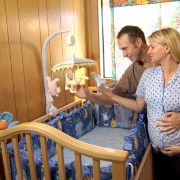 Photo: Getty Images
Photo: Getty Images
You’re a responsible parent. You always buckle your child in a properly installed car seat before every trip. You secure baby on the changing table and in a high chair, and you support his or her back with a nursing pillow. Unfortunately, you could be unknowingly endangering your child’s health.
Manufacturers have been adding flame-retardants to our clothing, furniture and electronics for decades to save lives by slowing combustion of the stuff that surrounds our lives. While these intentions are noble, most of us would prefer the cost of not bursting into flames to exclude toxic, carcinogenic, mutagenic, endocrine-disrupting and bio-accumulating chemicals entering our and our childrens' bodies every time we take a breath. According to new research, that is exactly what is happening.
Inspired by her first pregnancy, in 2009, Heather Stapleton, an assistant professor of environmental chemistry at Duke University’s Nicholas School of the Environment, led a team that tested baby products to see if flame retardants were present. “To the authors knowledge, this is the first study to report on flame retardants in baby products,” the study stated.
Stapleton chose to examine products that contain polyurethane foam because manufacturers often add relatively high concentrations of flame retardants to the foam and these chemicals can readily escape from the foam into our homes and other living environments.
The study found potentially toxic flame retardants in 80 percent of the polyurethane foam samples collected from 101 common baby products including bassinet mattresses, nursing pillows, high chairs, strollers, and other products that are designed for newborns, infants and toddlers. Among them were compounds associated with penta brominated diphenyl ethers (PBDE), suggesting that the substance - banned since 2004 in 172 countries and 12 U.S. states - still remains in use, as well as two potential carcinogens, TCEP and TDCPP.
In the study, published in the May 18, 2011 issue of the American Chemical Society’s journal Environmental Science & Technology, they found TDCPP was used the most often— in 36 percent of products—and in levels up to 12 percent the weight of foam. Stapleton's team estimated that infants' exposure to TDCPP might exceed federal Consumer Product Safety Commission’s acceptable daily intake levels.
Back in the 1970s, manufacturers of children’s pajamas added a synthetic chemical, tris(1,3-dichloro-2-propyl) phosphate or TDCPP, to their products after several children were fatally burned when their jammies caught fire. This flame retardant became the product of choice after it was discovered that another flame retardant, tris (2,3-dibromopropl) phosphate (TCEP) caused kids to absorb the carcinogenic and mutagenic chemical from wearing the PJs. TCEP was banned for use in 1977.
Seeking to meet government flammability standards, manufacturers then turned to other flame retardants, which have less health data available. The situation left gaps in knowledge about exactly which of the ubiquitous chemicals were being used in polyurethane foam products, and at what concentrations. Stapleton and her team set out to fill those gaps.
The Environmental Protection Agency (EPA) considers TDCPP to be a moderate cancer hazard and the lists it as a “probably human carcinogen.” The EPA also considers TDCPP to be a moderate hazard for reproductive and low cognitive development. In a written statement, the consumer agency said that TDCPP "may pose a significant health risk to consumers."
In an earlier study, Julie Herbstman of Columbia University found 97 percent of Americans, including newborns, have detectable PBDEs in their blood. Americans have 20 times higher levels than Europeans, because of strict U.S. laws requiring fire retardant use, especially in California. Average PBDE levels in Americans have doubled every four to six years since the 1970s, the 2010 study said.
Lynette Summerill is an award-winning writer who lives in Scottsdale, Arizona. In addition to writing about cancer-related issues for EmpowHER, her work has been seen in newspapers and magazines around the world.
Source: “Identification of Flame Retardants in Polyurethane Foam Collected from Baby Products.” Heather M. Stapleton et al. Environ. Sci. Technol., Article ASAP DOI: 10.1021/es2007462. Publication Date (Web): May 18, 2011. Available online: http://pubs.acs.org/doi/abs/10.1021/es2007462.
www.sciencedaily.com/releases/2011/05/110518075031.htm
www.jstor.org/pss/4540032
For more information about flame retardant chemicals visit the EPA’s website at http://www.epa.gov/opptintr/pbde/
Reviewed May 19, 2011
Edited by Alison Stanton





Add a Comment1 Comments
Wow! As a mother of two trying to sort through the seemingly never ending jungle of toxins in the foods we eat...I must admit it is overwhelming to now hear that my children's mattresses, car seats, our couches...even our clothes could be harmful to our health. Its also a slap in the face as an American to hear that certain chemicals...both in foods and in products...don't make the grade in other countries and are therefore not used, but somehow they pass the test in the U.S. We are surrounded by toxins...and 99% of us have no idea. I thank Ms. Stapleton for her work...this type of work is necessary in getting to the bottom of the sickness we face as a nation. Now...would someone give us parents a heads up as to exactly what products are harmful? In our capitalist nation, our consumer dollars are the only power we little people have to change the manufacturing practices that are killing us. If we stop buying...then perhaps these companies, and the FDA, will start to listen.
May 21, 2011 - 6:32amThis Comment